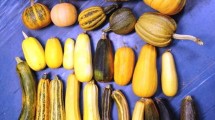Abstract
Cucurbita pepo, represented by cultivated forms of squash, pumpkins, and ornamental gourds, is a morphologically diverse species. Although several classifications of the cultivars have been proposed, none has been fully accepted. In an attempt to clarify the systematics of theC. pepo cultivars, allozyme variation was assayed. Twelve loci representing 6 enzyme systems (GOT, IDH, MDH, PER, PGI, and PGM) were screened. Seven of the loci were polymorphic. Electrophoretic data were collected for 50 accessions representing 14 commercial cultivars and a landrace from Mexico. Statistical analyses of the allozyme data revealed a biochemical basis for characterizing cultivars that agrees with morphology. Principal component analysis and cluster analysis revealed a major subdivision within the species above the level of cultivars. Genetic identities among groups of cultivars were much lower than those usually found among conspecific populations for outcrossing plants, possibly reflecting the influences of populational subdivision, drift, and selection particular toC. pepo.
Similar content being viewed by others
Literature Cited
Alefeld, F. 1866. Landwirtschaftliche Flora. Berlin.
Anonymous. 1957. New vegetable varieties. List IV. Proc Amer. Soc. Hort. Sci. 69: 574–587.
Bailey, L. H. 1929. The domesticated cucurbitas. Gentes Herb. 2: 62–115.
—. 1937. The Garden of Gourds. Macmillan, New York.
Carter, G. F. 1945. Plant Geography and Culture History in the American Southwest. Viking Fund Publ. in Anthropol. No. 5, New York.
Castetter, E. F. 1925. Horticultural groups of cucurbits. Proc. Amer. Soc. Hort. Sci. 22: 338–340.
Crawford, D. J. 1983. Phylogenetic and systematic inferences from electrophoretic studies.In S. D. Tanksley and T. J. Orton, ed, Isozymes in Plant Genetics and Breeding, Part A, p. 257–287. Elsevier, Amsterdam.
Cutler, H. C., and T. W. Whitaker. 1961. History and distribution of the cultivated cucurbits in the Americas. Amer. Antiquity 26: 469–485.
Erwin, A. T., and E. W. Haber. 1929. Species and varietal crosses in cucurbits. Iowa Agric. Exp. Sta. Bull. 263: 344–372.
Ford, R. I. 1980. ‘rtifacts’ that grew: their roots in Mexico. Early Man 2: 19–23.
Gilmore, M. R. 1930. Vegetal remains of the Ozark Bluff-Dweller culture. Pap. Michigan Acad. Sci. 14: 83–102.
Goff, E. S. 1888. Report of the horticulturist. New York Agric. Exp. Sta. Annual Rep. 6: 76–342. Gottlieb, L. D. 1981. Electrophoretic evidence and plant populations. Progr. Phytochem. 7: 1-46.
Kirkpatrick, K. J., D. S. Decker, and H. D. Wilson. 1985. Allozyme differentiation in theCucurbita pepo complex:C. pepo var.medullosa vs.C. texana. Econ. Bot. 39: 289–299.
Naudin, C. 1856. Nouvelles recherches sur les caractères spécifiques et les variétés des plantes du genreCucurbita. Ann. Sci. Nat. Bot. 6: 5–73.
Nei, M. 1972. Genetic distance between populations. Amer. Naturalist 106: 283–292.
— 1978. Estimation of average heterozygosity and genetic distance from a small number of individuals. Genetics 89: 583–590.
Ray, A. A. 1982. SAS User's Guide: Basics, 1982 ed. SAS Institute, Cary, NC.
Rohlf, F. J., J. Kishpaugh, and D. Kirk. 1980. NT-SYS, Numerical taxonomy system of multivariate statistical programs. Computer printout. State Univ. New York, Stony Brook, NY.
Swofford, D. L., and R. B. Selander. 1981. BIOSYS-1, A computer program for the analysis of allelic variation in genetics. Computer printout. Univ. Illinois, Urbana, IL.
Tapley, W. T., W. D. Enzie, and G. P. van Eseltine. 1937. The Vegetables of New York, Vol. 1, Part IV, The Cucurbits. New York Agric. Exp. Sta., Geneva, NY.
Whitaker, T. W. 1947. American origin of the cultivated cucurbits. Ann. Missouri Bot. Gard. 34: 101–111.
—, and G. F. Carter. 1946. Critical notes on the origin and domestication of the cultivated species ofCucurbita. Amer. J. Bot. 33: 10–15.
Author information
Authors and Affiliations
Rights and permissions
About this article
Cite this article
Decker, D.S. Numerical analysis of allozyme variation inCucurbita pepo . Econ Bot 39, 300–309 (1985). https://doi.org/10.1007/BF02858800
Received:
Accepted:
Issue Date:
DOI: https://doi.org/10.1007/BF02858800




